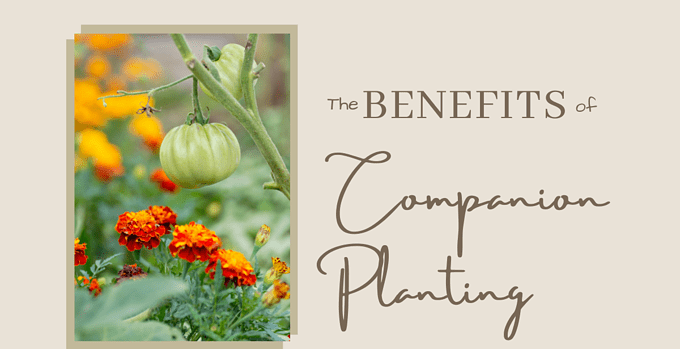What is Companion Planting and How Does it Work?
Companion planting benefits are numerous and widespread. Companion planting is a form of organic gardening that involves growing two or more plants together in close proximity. It is based on the idea that certain species of plants have beneficial relationships with each other and can help to improve soil quality, pest control, and overall health of the garden.
By strategically placing certain plants together, you can create a mutually beneficial environment for all species involved. This includes intercropping and crop rotation techniques to maximize the benefits of companion planting.
The Most Well-Known Companions
Perhaps the most well-known companions are known as the three sisters; corn, green beans and squash. There is a symbiotic relationship between these plants that perfectly portrays how companion planting works.
Corn, tall and thin, is a heavy feeder. Nitrogen-fixing pole beans are capable of using corn as a trellis and at the same time feeding them. Squashes or melons are the perfect ground cover to be planted at their feet. They sprawl across the ground using their large leaves to shade the soil, acting as a living mulch, keeping the soil cooler, protecting against moisture loss, and suppressing weeds. This is the type of relationship for which we aim with companion planting.
The Different Categories of Companion Plants
Companion planting is a great way to promote beneficial insect activity, provide nutrients and pest control, and even increase yields. Different types of companion plants can be used for different purposes.
Beneficial companion plants are those that repel pests and attract beneficial insects. Insect repellent plants can help keep harmful bugs away from your garden. Nitrogen fixing plants are great for providing nitrogen to the soil, which helps other nearby plants to grow better. Finally, pest control plants can help reduce the number of pests in your garden by providing them with an alternative food source or making it difficult for them to move around in your garden.
All these categories of companion plants have their own unique benefits and should be considered when planning a successful gardening experience.
Benefits of Companion Planting
Organic Pest Control
Attracting Beneficial Insects
Companion planting attracts predatory insects and parasitic wasps that will feed on garden pests such as squash bugs, aphids, hornworms, and more. It also attracts pollinators which are crucially important to all gardens.
Flowering plants are beautiful scattered throughout the garden however they are also very helpful in the garden. Flowers such as cosmos, zinnia, calendula, and borage are just a couple that are super attractive to bees!
Planting herbs like dill, cilantro, and basil will help to bring in beneficial insects that will attack other pests. Companion planting vegetables is an easy way to reduce pest issues in the garden by encouraging beneficial insects.
Trap Cropping
The use of sacrificial plants to pull harmful pests away from main crops. The plant most often used in this way is Nasturtium. There are actually quite a few reasons to grow nasturtium but this is a terrific one. I scatter it throughout my garden.
Repelling Pests
The use of some plants, such as ones with pungent smells, to deter pests from planting areas. The aroma of mint, while lovely to me, is something that many pests stay away from. Onions and garlic also help to ward off certain pests.
Enhancing the Soil
Companion planting naturally adds and adjusts elements in the soil. It helps to prevent compaction and erosion by combining multiple sizes and types of roots in the soil as well as the additional organic matter that is consequently added. It also assists in the biodiversity that is necessary for healthy plants by creating an ecosystem that encourages beneficial bacteria.
Large Harvests and Efficiency
Through the practice of companion planting, you can grow more crops in a smaller area, raising your potential harvests. Typically, when choosing plants to put together, they take up different spaces. For example, Tomatoes, with their larger and deeper root systems are many times planted alongside lettuce, which grows near the surface, therefore not competing with each other. In doing this, you can get multiple harvests out of the same plot of garden.
With more plants in a smaller area, their care is more efficient. Watering, weeding, and feeding one bed instead of three is more efficient. Therefore when planting in this fashion your work can be more streamlined.
Practical Tips for Successful Companion Planting in Your Garden
Companion planting is a great way to make your garden more productive, while also encouraging beneficial insects and reducing pest problems. Companion planting means growing different plants together in the same space, with the goal of creating an environment that is beneficial for both plants. It creates an ecosystem in which all aspects work together toward a common goal.
It can help you maximize your harvest and reduce the amount of time and effort you need to put into maintaining your garden. There are a few practical tips for successful companion planting in your garden, including how to plan a garden layout for companion planting and how to companion plant vegetables.
Planning your garden layout for companion planting is a great way to maximize your gardening success. You can try out different ideas, such as using a square grid to divide up your space or taking advantage of vertical space by growing plants up a trellis.
Below are images of the companion charts from my book, ‘Becoming Self-Sufficient‘, available on Amazon.
What are the Best Practices for Using Companion Plants to Create a Healthy Ecosystem?
Companion planting is a great way to create a healthy ecosystem in your garden. By planting the right combination of plants together, you can naturally control pests, improve soil quality, and attract beneficial insects.
Legumes are naturally nitrogen fixing and that solves a problem right there. Crop rotation is also something that adds to the overall health of the ecosystem that you are creating. Different plants attract different insects and bacteria.
When companion planting is employed, it sets up the right circumstances for all of those insects and bacteria to do the job that they are assigned. This is one of the reasons that taking an organic path is so very important. Using pesticides affects more than just the bad bugs. It affects the good ones too; the ones that your garden truly needs.
Best Practices for Using Companion Plants to Create a Healthy Ecosystem:
-Select plants that grow well together and are beneficial to each other
My suggestion is always to start with your main food crops as the center of your plan. When researching those particular crops and their companions, begin with plants that assist their growth and health. For example, when researching tomatoes, you will find that basil is an excellent plant to grow with your tomatoes, as it helps their growth and flavor.
The next thing that you would want to look at is plants that can help protect them from pests. Borage and marigolds are terrific plants to put with your tomatoes as they not only help with pest control but also attract pollinators, which is crucial.
There are many different places where you can find companion planting charts, however, you shouldn’t stop there. They typically offer some good companion choices as well as some bad companions. However, when you research a specific crop’s companions, you can find much more detailed information. As always, I’ll reiterate, doing your research is so important.
-Plant them in a way that they can receive the optimal sunlight and water without competing with each other’s root systems.
I mentioned earlier that the root systems should be taken into consideration during the planning process, but you also have to consider sunlight requirements. Some companion strategies can take care of this problem for you. Lettuce will do well with the afternoon shade that tomato plants can offer if planted with that purpose in mind.
Something else that this planting arrangement assists is water consumption and weed control. The lettuce in this scenario acts as a living mulch, helping to shade out weeds and keep the soil from drying out as easily.
-Choose plants with similar soil requirements.
Certainly, you want to make sure that the plants have the same pH requirements but also their water needs. Some plants need way more water than others, so you don’t want to take the chance of drowning one while watering another.
-Companion planting methods as chemical pest control
I touched on this above and it is one of the most significant benefits of companion planting. There are so many options and combinations to make this happen. You just need to research your crops. However, I’ll give you some of my favorites.
Calendula is a flowering herb that I grow EVERYWHERE throughout my garden. It has so many uses and there is simply no reason I can think of to not include it. Along the same lines, marigolds and nasturtium are plants that should just be scattered everywhere as well.
Conclusion: Start Growing with the Benefits of Companion Planting Today!
As long as you do a little research on the companions of your main crops, it is a simple process to get started companion planting. You do not HAVE to start big and companion plant every inch of your garden right off the bat. You can start with a few companions that are generally beneficial to your garden and go from there. Don’t let yourself get overwhelmed, just get your hands dirty and get started!
MORE WAYS TO CONNECT
We also, as a homesteading family, have three additional blogs that might interest you. A Life on the Farm focuses on the more personal side of the homesteading life. We discuss subjects like family, parenting, relationships, homeschooling, cooking, canning and so much more.
Farm Raised Family is basically a hub for everything under the Two Oaks Farmstead umbrella. You can learn a great deal about all parts of the farmstead there. The Farm Raised Family blog focuses on financial matters such as budgeting, saving, and more and on current events affecting families.
You can also have a more in depth look at all that we do by visiting our Two Oaks Farmstead YouTube Channel and be sure to subscribe so that you don’t miss a thing!
Farm Life and Freedom is the new podcast we are in the process of launching! It is going to be so much fun! You could also check in with our Farm Life and Family Youtube Channel.
Two Oaks Farmstead is the farm store… the one that holds the umbrella! Check us all out and join us, not only on our blogs and Farm Life and Freedom podcast but come join the fun on Facebook, Instagram, Twitter… wherever you get social!




